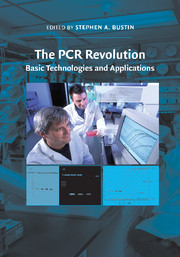Book contents
- Frontmatter
- Contents
- Contributors
- Foreword by Russell Higuchi
- Preface
- I BASIC TECHNOLOGIES
- 1 Real-time polymerase chain reaction
- 2 Thermostable enzymes used in polymerase chain reaction
- 3 Inventing molecular beacons
- 4 Rapid polymerase chain reaction and melting analysis
- 5 Polymerase chain reaction and fluorescence chemistries: deoxyribonucleic acid incarnate
- 6 Analysis of microribonucleic acid expression by quantitative real-time polymerase chain reaction
- 7 Miniaturized polymerase chain reaction for quantitative clinical diagnostics
- 8 The road from qualitative to quantitative assay: What is next?
- 9 Taking control of the polymerase chain reaction
- II APPLICATIONS
- Index
- Plate section
- References
7 - Miniaturized polymerase chain reaction for quantitative clinical diagnostics
Published online by Cambridge University Press: 25 January 2011
- Frontmatter
- Contents
- Contributors
- Foreword by Russell Higuchi
- Preface
- I BASIC TECHNOLOGIES
- 1 Real-time polymerase chain reaction
- 2 Thermostable enzymes used in polymerase chain reaction
- 3 Inventing molecular beacons
- 4 Rapid polymerase chain reaction and melting analysis
- 5 Polymerase chain reaction and fluorescence chemistries: deoxyribonucleic acid incarnate
- 6 Analysis of microribonucleic acid expression by quantitative real-time polymerase chain reaction
- 7 Miniaturized polymerase chain reaction for quantitative clinical diagnostics
- 8 The road from qualitative to quantitative assay: What is next?
- 9 Taking control of the polymerase chain reaction
- II APPLICATIONS
- Index
- Plate section
- References
Summary
CURRENT QUANTITATIVE POLYMERASE CHAIN REACTION USES IN QUANTITATIVE CLINICAL DIAGNOSTICS
Clinical diagnostics is progressively embracing the incorporation of translational medicine, as the diagnostic industry starts to lean toward personalized treatment. Direct benefits to clinical diagnostics will be achieved as a result of technical advancements providing unambiguous quantitative analysis of the transcriptome, although the quantitative clinical diagnostic sector is a relatively small part of the overall clinical diagnostic market. Interests in deoxyribonucleic acid (DNA) and messenger ribonucleic acid (mRNA) detection and quantification have improved current knowledge of cell functions, including cell regulation, growth, expression markers, and transcription. The polymerase chain reaction (PCR) is one such research technique in mainstream clinical diagnostics that can provide quantitative analysis and assist in closing the “bench to bedside” gap found with translational medicine.
The reverse transcription–PCR (RT–PCR) is at present the most sensitive technique for mRNA detection, although quantitative RT–PCR (qRT–PCR) increasingly provides robust PCR product measurements from each cycle. Additionally, qPCR is commonly applied to clinical diagnostics, making the technique an industry standard for RNA product detection and quantification. An increase in qPCR applications, combined with the growing importance of clinical diagnostics, has permitted both areas to develop in parallel. Reflecting these advancements, the value of qPCR in quantitative clinical diagnostics has increased largely through the stochastic integration of fluorochrome that can be directly related to qualitative measurements. Qualitative end-point PCR measurements benefit from many of the detection strategies used in qPCR, but obviously lack quantitative application.
- Type
- Chapter
- Information
- The PCR RevolutionBasic Technologies and Applications, pp. 88 - 109Publisher: Cambridge University PressPrint publication year: 2009

